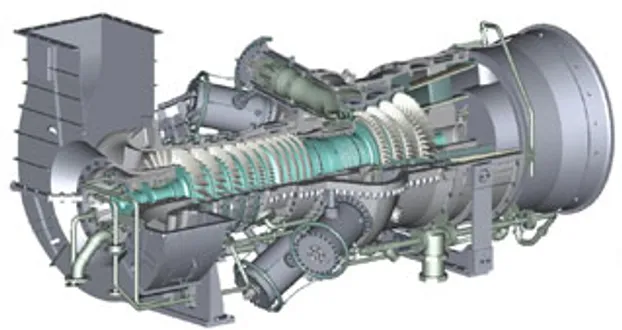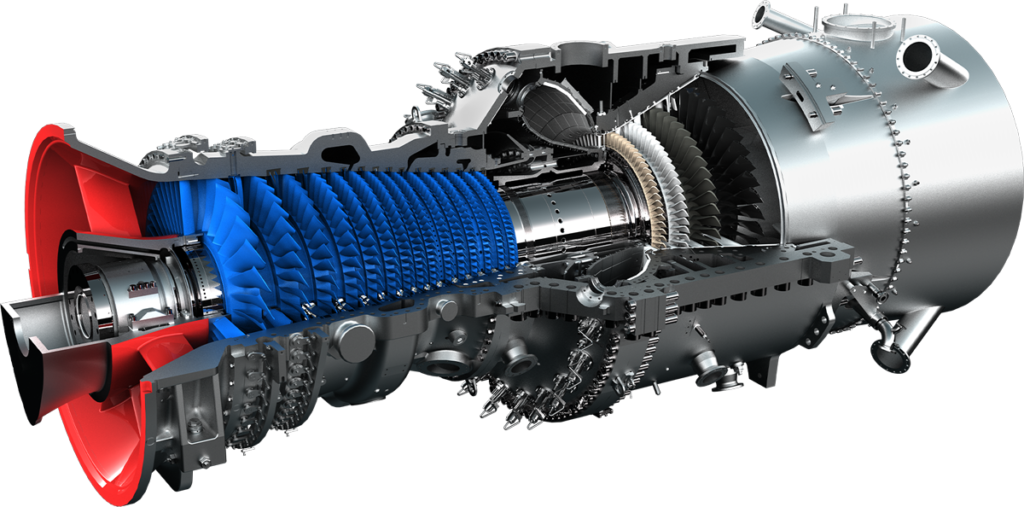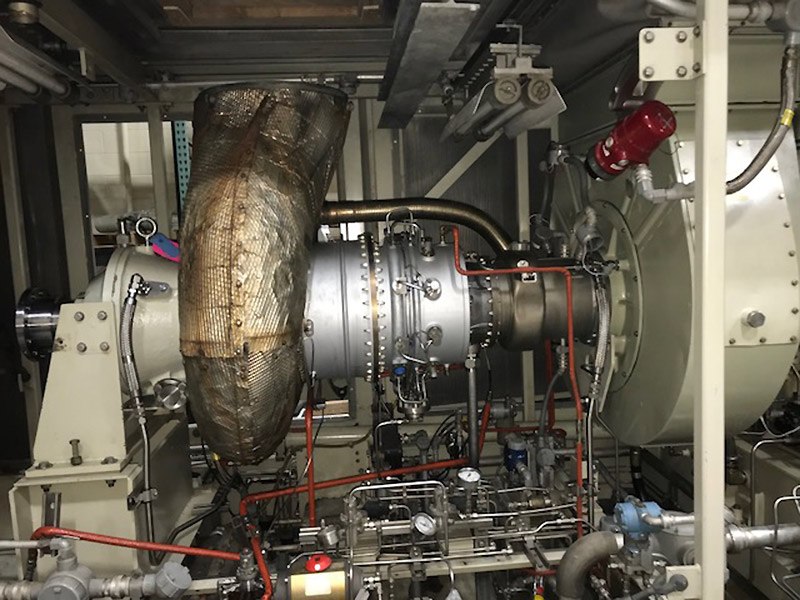RECENT ADVANCES IN TECHNOLOGY - 1 / GAS TURBINES

USING HYDROGEN AS FUEL IN GAS TURBINES
ADVANTAGES & DISADVANTAGES USING HYDROGEN FUEL INSTEAD OF NATURAL GAS
Advantages of using hydrogen as fuel in industrial gas turbines:
Reduced greenhouse gas emissions: Hydrogen produces no carbon dioxide emissions when burned, making it an attractive option for reducing greenhouse gas emissions and meeting carbon reduction targets.
High energy content: Hydrogen has a higher energy content per unit of volume than natural gas, which means that less fuel is required to produce the same amount of power.
Wide availability: Hydrogen can be produced from a variety of sources, including natural gas, coal, and renewable sources such as solar and wind power.
Increased fuel flexibility: The use of hydrogen as a fuel in industrial gas turbines can increase fuel flexibility and reduce reliance on fossil fuels.
Disadvantages of using hydrogen as fuel in industrial gas turbines:
Cost: The cost of producing and storing hydrogen is currently higher than that of natural gas, which may make it less attractive for some applications.
Safety concerns: Hydrogen is a highly flammable gas that can pose safety risks if not handled properly. Special safety measures are required for its storage and handling.
Material compatibility: Hydrogen can cause embrittlement in some metals, which may limit the use of certain materials in turbine components.
Infrastructure requirements: A significant investment in infrastructure is required to produce, store, and transport hydrogen, which may be a barrier to its widespread adoption.
In order to improve the reliability, maintainability, availability, and safety of hydrogen-fueled industrial gas turbines, it is important to carefully consider the advantages and disadvantages of hydrogen and develop appropriate mitigation strategies for any potential risks. These strategies may include investing in research and development to reduce the cost of hydrogen production and storage, implementing strict safety protocols for hydrogen handling and storage, and selecting materials that are compatible with hydrogen to avoid component failures and unscheduled shutdowns. Additionally, a well-designed maintenance and monitoring program should be implemented to ensure that the equipment is operating within safe and efficient parameters.
LIMITATIONS IN ENGINEERING & DESIGN USING HYDROGEN AS FUEL INSTEAD OF NATURAL GAS
The use of hydrogen as fuel in industrial gas turbines presents several engineering and design challenges that must be addressed to ensure reliable and safe operation. Some of the limits in engineering and design include:
Material compatibility: Hydrogen has a different molecular structure than natural gas, which can cause embrittlement and other damage to certain metals used in turbine components. This can limit the selection of materials and require special coatings or treatments to ensure compatibility.
Combustion dynamics: Hydrogen combustion can exhibit different dynamics than natural gas, including higher flame speeds and more rapid combustion. This can lead to increased vibration and mechanical stresses on turbine components, which must be accounted for in the design.
Combustion stability: Hydrogen combustion can be less stable than natural gas combustion, which can lead to flameout or other instability issues that can cause unscheduled shutdowns or even damage to the turbine.
Fuel delivery and storage: Hydrogen must be stored and delivered to the turbine at high pressures, which can require special handling and storage equipment. Additionally, the high flammability of hydrogen requires strict safety protocols for fuel handling and storage.
Cost: The cost of hydrogen production and storage is currently higher than that of natural gas, which can make it less economically attractive for some applications.
To address these limits in engineering and design, it is important to carefully evaluate the suitability of hydrogen as a fuel for specific applications and develop appropriate mitigation strategies for any potential risks. This may involve conducting extensive testing and analysis to ensure that the turbine is capable of handling hydrogen combustion dynamics and developing specialized coatings and materials to ensure compatibility. Additionally, robust safety protocols and equipment must be implemented for hydrogen fuel storage and delivery. Careful consideration of the economic and environmental benefits of hydrogen must also be taken into account in order to justify the increased cost of production and storage. A well-designed maintenance and monitoring program should also be implemented to ensure that the equipment is operating within safe and efficient parameters.

WHY, WHERE, WHEN TO USE HYDROGEN FUEL IN INDUSTRIAL GAS TURBINES INSTEAD OF GAS NATURAL
WHY:
Environmental benefits: Hydrogen is a clean-burning fuel that produces no greenhouse gas emissions when burned. This can help companies meet emissions reduction targets and regulatory requirements, as well as improve their sustainability profile.
Fuel diversity: Using hydrogen as a fuel can diversify a company’s fuel portfolio, reducing reliance on traditional fossil fuels and increasing energy security.
Energy efficiency: Hydrogen has a higher energy content per unit of weight than natural gas, which can lead to higher efficiency and potentially lower fuel costs.
WHERE:
Off-grid or remote locations: Hydrogen can be produced on-site using renewable energy sources, making it a suitable option for power generation in off-grid or remote locations.
Emissions-sensitive areas: In areas with strict emissions regulations, such as cities or urban areas, using hydrogen as a fuel can help companies meet regulatory requirements.
Greenfield projects: New projects that are designed from the ground up to use hydrogen as a fuel can take advantage of the benefits of hydrogen without needing to retrofit existing equipment.
WHEN:
When emissions reduction is a priority: If a company has ambitious emissions reduction targets or is operating in an industry with high emissions intensity, using hydrogen as a fuel can help meet these goals.
When there is access to low-cost hydrogen: Hydrogen production costs are decreasing as technology advances, and if a company has access to low-cost hydrogen, it may be an economically viable fuel option.
When there is suitable equipment and infrastructure: Hydrogen combustion requires specialized equipment and infrastructure, so companies should evaluate whether their existing equipment can be retrofitted or if new equipment needs to be installed.
Overall, the decision to use hydrogen as a fuel should be based on a careful evaluation of the benefits and limitations in the specific context of the application. While hydrogen can offer significant environmental benefits and fuel diversity, it requires specialized equipment and infrastructure and may not be economically viable in all situations.
PROCEDURES, ACTIONS, STUDIES AND RECOMMENDATIONS TO USE HYDROGEN AS FUEL
Implementing the use of hydrogen as a fuel in industrial gas turbines requires careful planning and execution to ensure reliability, maintainability, availability, and safety. Below are some procedures, actions, studies, and recommendations to consider:
Feasibility Study: Conduct a feasibility study to determine whether hydrogen is a suitable fuel option for the specific application. This study should consider factors such as the availability and cost of hydrogen, equipment compatibility, and regulatory requirements.
Risk Assessment: Conduct a thorough risk assessment to identify potential hazards associated with the use of hydrogen as a fuel. This assessment should consider the entire fuel supply chain, including storage, transportation, and handling.
Equipment Selection: Select equipment that is compatible with hydrogen combustion, including gas turbines, compressors, and ancillary equipment. Equipment should be designed for high reliability and availability, and maintenance should be performed regularly.
Infrastructure: Ensure that the infrastructure required for hydrogen production, storage, and transportation is designed and operated safely and reliably.
Fuel Quality: Ensure that the hydrogen used as a fuel meets appropriate quality standards, including purity and moisture content.
Training and Procedures: Provide appropriate training for operators, maintenance personnel, and emergency responders on the safe handling and use of hydrogen. Develop and implement procedures for fuel handling, storage, and emergency response.
Regulatory Compliance: Ensure that all applicable regulatory requirements are met for the safe use of hydrogen as a fuel. This may include permitting, reporting, and emergency response planning.
Testing and Monitoring: Conduct testing and monitoring to ensure that equipment is operating as intended and to detect any potential issues before they lead to critical failures or unscheduled shutdowns.
Continuous Improvement: Implement a continuous improvement program to identify opportunities for optimization and to improve reliability, maintainability, availability, and safety over time.
In summary, using hydrogen as a fuel in industrial gas turbines requires a comprehensive approach that considers all aspects of the fuel supply chain, equipment selection and operation, infrastructure, training and procedures, and regulatory compliance. By following these procedures, actions, studies, and recommendations, companies can improve reliability, maintainability, availability, and safety and avoid critical failures and unscheduled shutdowns.

CRITICAL RISKS USING HYDROGEN FUEL INSTEAD OF NATURAL GAS IN GAS TURBINES
Using hydrogen as a fuel in industrial gas turbines involves certain critical risks that need to be addressed to ensure the safety and reliability of the system. Some of these risks include:
Fire and Explosion: Hydrogen has a wide flammability range and is highly combustible, making it a potential fire and explosion hazard. A leak in the fuel supply system or an ignition source can result in a fire or explosion.
Material Compatibility: Hydrogen can cause embrittlement in some materials, leading to equipment failure. Compatibility of materials with hydrogen should be assessed to ensure the safe operation of equipment.
Hydrogen Purity: The purity of hydrogen used as a fuel is critical to the safe operation of gas turbines. Impurities in the fuel can cause corrosion, fouling, and damage to the turbine components.
Safety Systems: Adequate safety systems should be in place to detect and mitigate any hydrogen leaks or other hazards. These systems should include gas detectors, fire suppression systems, and emergency shutdown systems.
Fuel Supply Chain: The safety of the entire hydrogen supply chain, including production, transportation, and storage, needs to be addressed to ensure the safe operation of the gas turbine.
Regulatory Compliance: Compliance with regulatory requirements for the safe use of hydrogen as a fuel is critical to avoid any safety hazards. Regulatory requirements may include permits, reporting, and emergency response planning.
Maintenance: Maintenance of equipment is critical to the safe and reliable operation of the gas turbine. Regular maintenance and inspection should be performed to detect any potential issues before they result in equipment failure or safety hazards.
In summary, the critical risks associated with using hydrogen as a fuel in industrial gas turbines include fire and explosion hazards, material compatibility, hydrogen purity, safety systems, fuel supply chain, regulatory compliance, and maintenance. Addressing these risks through appropriate safety measures and procedures is necessary to ensure the safe and reliable operation of the gas turbine and to avoid critical failures and unscheduled shutdowns.
